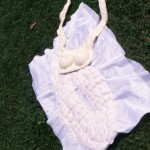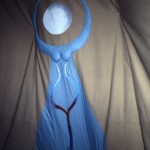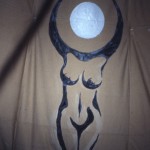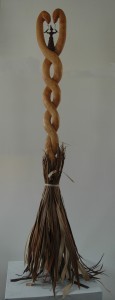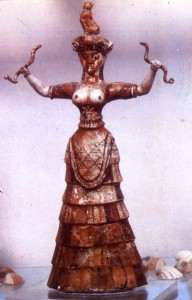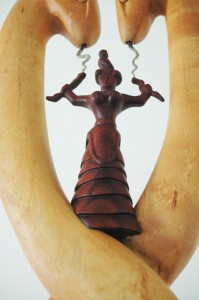 The Rainbow Tipi was one of Rae’s first large pieces as a student artist, around 1981 We were living in a trailer park in Iowa City, I was working at the Amana Furniture & Clock Shop, Rae was taking classes at the U of Iowa. She was exploring her Native heritage, getting a few stories out of her mother, grandmother, other family.
The Rainbow Tipi was one of Rae’s first large pieces as a student artist, around 1981 We were living in a trailer park in Iowa City, I was working at the Amana Furniture & Clock Shop, Rae was taking classes at the U of Iowa. She was exploring her Native heritage, getting a few stories out of her mother, grandmother, other family.
Her vision was for a portable shrine or temple as the Yurt would later be. She researched the history and construction of Tipis, checked methods for decorating canvas, and designed the interior.
We had a small craft business, our own and consignment, we called The Enchanted Glade, in the “Hall Mall” in downtown Iowa City. The name changed to the Rainbow Tipi when we moved to Ames later, in honor of the tipi, which we took camping to several pagan gatherings, and lived in our last 8 months in Iowa City, with both the boys as young kids.
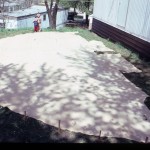
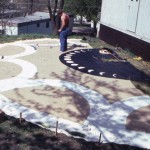
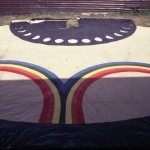 The canvas for the cover was laid out in our tiny yard in the trailer park, the design penciled on, then gesso wherever the paint was to go, then pencil again, using string to draw the arcs of the rainbow after figuring out how to get exactly 5 rainbows in the hemisphere. The edge was painted black for about 14 inches, and around the top, the smoke hole, were the phases of the moon on a black background.
The canvas for the cover was laid out in our tiny yard in the trailer park, the design penciled on, then gesso wherever the paint was to go, then pencil again, using string to draw the arcs of the rainbow after figuring out how to get exactly 5 rainbows in the hemisphere. The edge was painted black for about 14 inches, and around the top, the smoke hole, were the phases of the moon on a black background.
The interior of the tipi had a tipi liner, common in modern tipis, to allow air to come in around the base, flow between the tipi and inner liner, and then out, creating a draft to take smoke out, and keep the tipi cool in warm weather.
The liner was designed with 5 goddess figures on it, connected by more rainbows. The door was was through a flame-circled womb. A buffalo-woman made of felt, a water-goddess of blue silk with beadwork , a painted tree-bark inspired Earth Goddess, a spider-woman, and I just can’t remember what the last one was…Air? (several of these were later resurrected for the Yurt). Each one had her arms curbing upward, and a silver painted moon/mirror in place of a head.
We used the tipi as a home, for camping at several Pagan events, and when we moved to Madison, we put it up out at Barb and Cal’s farm, then a CSA, west of Madison. They used it for some rituals, and as temporary shelter for some of their workers, I believe. Eventually, as all canvas does, it was lost to the elements. We had taken out the liner to store, since it was more fragile and we didn’t want the elements ruining it. Which is how some of the interior pieces ended up in the Yurt piece.

